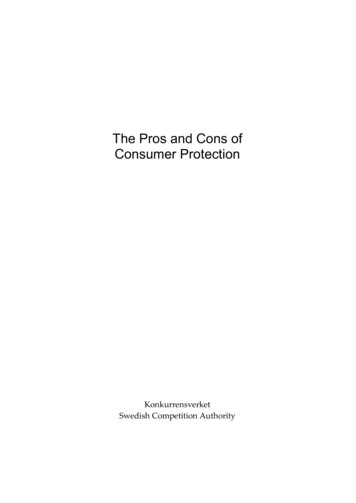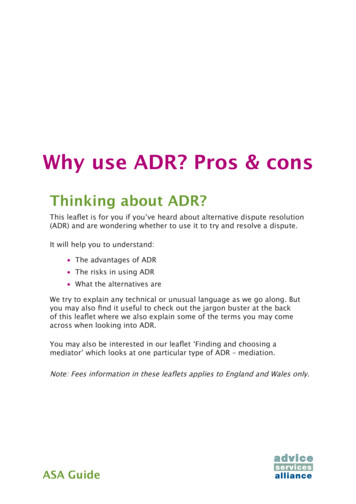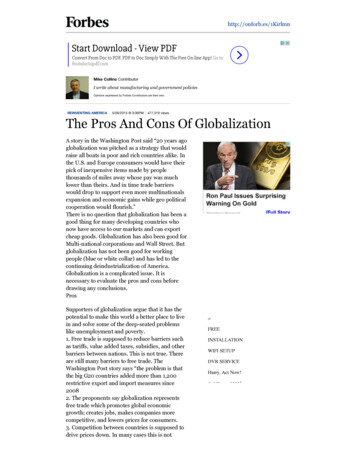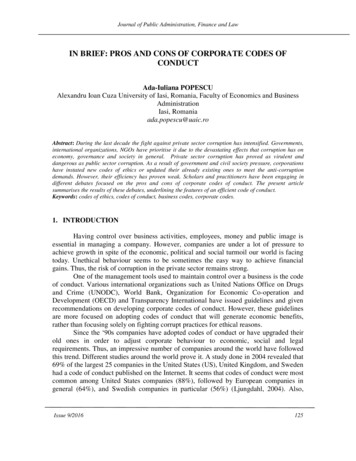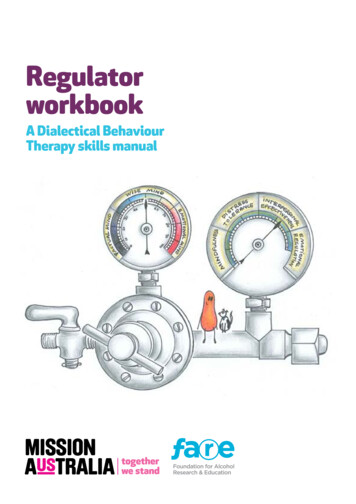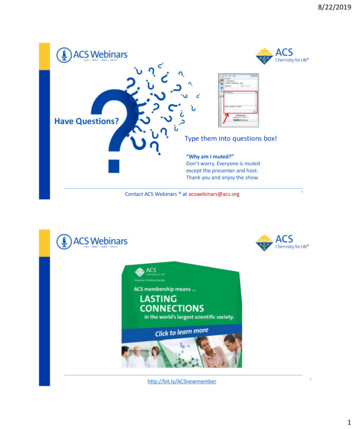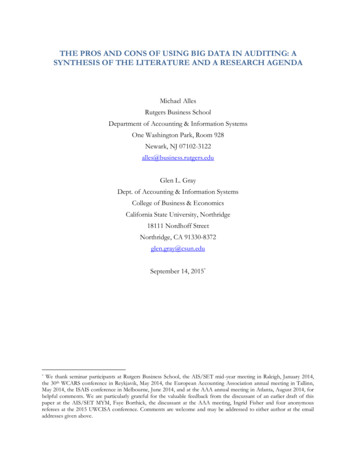
Transcription
THE PROS AND CONS OF USING BIG DATA IN AUDITING: ASYNTHESIS OF THE LITERATURE AND A RESEARCH AGENDAMichael AllesRutgers Business SchoolDepartment of Accounting & Information SystemsOne Washington Park, Room 928Newark, NJ 07102-3122alles@business.rutgers.eduGlen L. GrayDept. of Accounting & Information SystemsCollege of Business & EconomicsCalifornia State University, Northridge18111 Nordhoff StreetNorthridge, CA 91330-8372glen.gray@csun.eduSeptember 14, 2015*We thank seminar participants at Rutgers Business School, the AIS/SET mid-year meeting in Raleigh, January 2014,the 30th WCARS conference in Reykjavik, May 2014, the European Accounting Association annual meeting in Tallinn,May 2014, the ISAIS conference in Melbourne, June 2014, and at the AAA annual meeting in Atlanta, August 2014, forhelpful comments. We are particularly grateful for the valuable feedback from the discussant of an earlier draft of thispaper at the AIS/SET MYM, Faye Borthick, the discussant at the AAA meeting, Ingrid Fisher and four anonymousreferees at the 2015 UWCISA conference. Comments are welcome and may be addressed to either author at the emailaddresses given above.*
THE PROS AND CONS OF USING BIG DATA IN AUDITING: ASYNTHESIS OF THE LITERATUREAbstract With corporate investment in Big Data of 34 billion in 2013 growing to 232billion through 2016 (Gartner 2012), the Big 4 professional service firms are aiming to be at theforefront of Big Data implementations. Notably, they see Big Data as not only an opportunity fortheir consulting arms, but also as an increasingly essential part of their assurance practice. We arguethat while there is a place for Big Data in auditing its application to auditing is less clear cut than it isin the other fields to which it already has been applied, such as marketing and cancer research. Theobjectives of this paper are to: (1) provide a balanced discussion of both the pros and the consregarding incorporating Big Data into financial statement audits; and (2) present a research agenda toidentify specific aspects of Big Data that could benefit auditors.Keywords Big Data, auditing, accounting information systems1
1. Introduction1.1Increasing interest in Big Data by AuditorsA survey by Gartner (2014) found that 73% of respondents had invested or planned toinvest in Big Data in the next 24 months, up from 64% in 2013. With corporate investment in BigData of 34 billion in 2013 growing to 232 billion through 2016 (Gartner 2012), the Big 4professional service firms are eagerly competing with such firms as SAP and IBM for the growingmarket in Big Data. Notably, they are declaring that Big Data is not only an opportunity for theirconsulting arms, but also an increasingly essential part of their assurance practice.1 For example, EYstates: “The audit of the future will bear little resemblance to the traditional audit CFOs are accustomed to receivingtoday. In fact, the way organizations conduct audits will change more in the next 5-10 years given the evolution oftechnology and analytics. Data analytics, new technology and access to detailed industry information will all combine tohelp auditors better understand the business, identify risks and issues and deliver additional insights. Moreover, theability to review and analyze entire sets of data, rather than applying sampling techniques, will help bring moreconfidence to the audit.”2Similarly, Deloitte Chairman and CEO Joe Ucuzoglu writes: “At Deloitte we’re investing severalhundred million dollars in data analytics and artificial intelligence with some cutting-edge applications that we reallybelieve differentiate us and our audit approach. When we use these tools, we’re able to get greater coverage. We’re ableto more quickly identify risks. We’re able to complete the audit with a higher level of quality and ultimately deliver agreater level of insight to our clients.”3In the light of these dramatic and costly developments in practice, we examine in this paperthe pros and cons of using Big Data as an audit tool. With so much of the attention emphasizing theformer, we unapologetically point out the latter in order to get a more balanced perspective on whatpromises to be a revolutionary change in auditing. Our objective is not to be naysayer to this change,Although accounting firms could conduct a wide variety of engagements under a variety of professional standards; thispaper focuses on financial statement audits conducted in compliance with the Statements of Auditing Standards (SASs)published by the AICPA, Auditing Standards (ASs) published by the PCAOB, and International Standards on Auditing(ISAs) published by the L CONUSDD9XAN4E&utm source eycom&utm medium homepage PF&utm campaign Future%20of%20audit#introduction.Accessed 9/1/2015 1:26:52 re-accountingtoday-article.html. Accessed 9/1/2015 1:32:53 PM.12
but to play the role of a devil’s advocate, arguing for the need for auditors to exercise due care whenembracing this new methodology.We will show that while there is a place for Big Data in auditing its application to auditing isless clear cut than it is in the other fields to which it already has been applied, such as marketing andcancer research.4 To put our approach into proper perspective, we refer to AU Section 230paragraph .07 which states: “Professional skepticism is an attitude that includes a questioning mind and a criticalassessment of audit evidence. The auditor uses the knowledge, skill, and ability called for by the profession of publicaccounting to diligently perform, in good faith and with integrity, the gathering and objective evaluation of evidence.” 5Skepticism is not a negative in auditing, but the positive force from which value is created. Similarly,we bring professional skepticism to bear on the potential role of Big Data in auditing practice inorder to better understand when it will add value and when it will not.1.2The Inevitably of Big Data in Auditing Versus the Historical RecordAt a theoretical or normative level it seems logical that auditors will incorporate Big Datainto future financial audits (Littley, 2012; Moffitt and Vasarhelyi, 2013; Setty and Bakhshi, 2013; IIA2013; Whitehouse 2014; AICPA 2014). Big data potentially paints a very robust picture of theclient’s activities, far beyond that possible to be captured using only the far smaller population ofGAAP-compliant data. A key requirement of auditing standards is setting expectations at thebeginning of the audit—an issue that PCAOB inspectors are particularly critical of in their reports.A core component of audit planning is establishing “expectations developed from data derived from othersources” (AU 329.16) before collecting and analyzing financial data.6 Setting expectation based on“disaggregate data” is a reoccurring theme in Staff Audit Practice Alert No. 12 (PCAOB 2014) toimprove auditing of revenue, which was motivated by the PCAOB’s frequent criticism of revenueauditing in their accounting firm inspection reports. The PCAOB is also pushing accounting firmsto boost their fraud detection procedures in compliance with AU 316.Zhang, Yang and Appelbaum (2015), Cao, Chychyla and Stewart (2015) and Yoon,Hoogduin, and Zhang (2015) argue that Big Data will enable auditors to improve their effectivenessInterestingly, PWC itself advertises their use of Big Data methods to help cancer researchers, presumably as part .com/?utm campaign Extraordinary&utm medium Feature&utm source Omnibus#medical. Accessed 9/1/2015 1:41:17 PM.5 t/DownloadableDocuments/AU-00230.pdf.Accessed 9/2/2015 9:24:36 AM.6 t/DownloadableDocuments/AU-00329.pdf.Accessed 9/2/2015 9:26:51 AM.43
in all these areas and more. These articles, all in the Big Data Forum published in the June 2015issue of Accounting Horizons, assume the inevitability of incorporating Big Data into financialstatement auditing. In September 2015 the American Accounting Association (AAA) held its first“Accounting is Big Data” conference which one of the authors attended.7 In this conference too itwas simply taken for granted that Big Data will be the future of auditing, though few examples of itsuse specific to accounting or auditing were presented.In this paper we temper this optimism about the use of Big Data in auditing in light of theempirical evidence that accounting firms have had a mixed history of implementing assurancerelated technologies. The 1996 Special Committee on Assurance Services Report (the Elliott Report)predicted that the annual fees for the assurance services recommended in that report would reach 14 to 21 billion (two to three times the 7 billion annual fees collected for financial statementaudits). E-commerce assurance services (later called WebTrust) alone was predicted to generate 1.25 to 6.25 billion annually, far in excess of the reality today.Regarding technology for financial statement audits specifically, articles equally optimistic tothe Accounting Horizons Big Data articles (some by the same authors) were published in the past aboutartificial intelligence (AI), expert systems, data mining, and continuous auditing [CA]. Over 30 yearsago, the then Big 6 were spending millions of dollars developing expert system applications. Brown(1991) listed 43 expert systems in use or under development by the then Big 6; yet according toGray, Chiu, Liu, and Li (2014), none of these applications became part of regular audit activities.Researchers have been promoting continuous auditing and continuous monitoring [CM] for nearly aquarter century (Vasarhelyi and Halper 1991), but as the AICPA states, “The general view is that notmuch is currently being done with CA/CM.”8 More recently, articles (e.g., Debreceny & Gray 2010 and2011 and Gray and Debreceny 2014) have illustrated how various forms of data mining could bevaluable resources for auditors, but generally this technology is isolated to special forensicengagements.Notwithstanding this discouraging record, we are not saying the accounting firms mademistakes not implementing these and other technologies as a regular part of traditional financialaudits. Audit standards AS No. 15, SAS No. 122 (AU-C sec. 500) and ISA 500, all essentially say[Quoting from SAS No 122.04]: “The objective of the auditor is to design and perform audit procedures ig-Data. Accessed 9/9/2015 8:08 eadvisoryservices/downloadabledocuments/whitepaper currentstate-continuous-auditing-monitoring.pdf. Accessed 9/3/2015 9:43:58 AM784
enable the auditor to obtain sufficient appropriate audit evidence to be able to draw reasonable conclusions on which tobase the auditor's opinion.” [Emphasis added]. Since tens of thousands of audits are completed eachyear, auditors currently believe they are collecting sufficient appropriate audit evidence to draw reasonableconclusions without these technologies. As such, the overarching research question regarding newtechnologies and financial statement audits is: how or where can these technologies cost-effectivelyimprove the efficiency and/or effectiveness of audits? More specifically to Big Data analytics: whatparts of the current data gathering and analysis procedures can Big Data analytics be cost-effectivelysubstituted? We say substituted because we assume Big Data analytics will not simply be added tocurrent audit procedures—and that accounting firms will just increase their audit fees to reflect thisaddition.It should also be noted that the use of the term big data by auditors—both on the academicand practitioner side—is not always consistent with its definition in the wider data analyticscommunity. In particular, the long reliance of auditors on sampling means that the extension to theanalysis of the whole population of accounting transactions may well be considered “big data” in anauditing environment. But, as we show below—despite the AAA’s assertion that “Accounting is BigData—even the entirety of a business’s accounting transactions is several orders of magnitudesmaller than the data sets that proponents of big data outside auditing have in mind. Whendiscussing big data in an audit context, there is also the need to differentiate between more of thesame kind of data that auditors are already using, or more data of a different kind than what auditorshave traditionally relied on to give an audit opinion. The former approach would lead, for example,to continuous auditing where the scope of data is not necessarily expanded but measurements aretaken more frequently in time (Kogan, Alles, Vasarhelyi and Wu, 2014). By contrast, big data pushesthe domain of data far outwards from financial data to non-financial data—from structured tounstructured data and from inside the organization to outside it—to an extent that may well beoutside the comfort zone and technical capability of the audit profession as it is currentlyconstituted.91.3Costs and Benefits of Using Big Data in AuditingJust because the benefits of a technology outweigh the costs for a client’s organization doesnot automatically mean that the same technology is cost-beneficial for the auditors, particularly inFor example, a senior technical partner at a Big-4 firm known for its statements extolling its commitment to the use ofBig Data in auditing, told the authors that in reality the firm focusses almost entirely on structured data and not what heand other consider to be true, unstructured, Big Data,95
the heavily regulated and litigious environment in which accounting firms must function.Cost/benefit decisions, by their very nature, are very different for partnerships vs. corporations. Forexample, consider a situation where the client corporation and their Big 4 auditors are essentially thesame size. If someone in the corporation proposes a 25 million technology modernization project,the CEO, CFO, or other executives do not calculate what that’s going to personally cost them (Whatpart of that 25 million will come out of my pocket?). At a partnership, partners automaticallydetermine in their head what that project is going to personally cost them based on the prior year’sprofit distribution formula. In other words, conceptually, each partner does his or her owncost/benefit calculation. Although it’s nearly 25-years old, to see an example of this thinking, see theHarvard Business School case study called “KPMG Peat Marwick: The Shadow Partner,” (Ecclesand Gladstone 1991).10As we discuss in this paper, using a client’s Big Data as regular part of that client’s financialaudits would be a paradigm shift, requiring unprecedented access to proprietary and sensitive clientdata that are outside tradition data requested during an audit; a significantly higher reliance on nonfinancial data (NFD), which auditors have been reluctant to use in the past because it’s not clearhow validate this non-GAAP data; increased technical skills on the part of the audit team; andincreased business acumen to determine what data to analyze and how to interpret the results.To reiterate, however, we are not saying Big Data will not be incorporated into financialstatement audits. We have already mentioned the investments in Big Data by Deloitte and E&Y, andPwC is undertaking a pilot study of ten audit clients to which they are applying Big Datatechniques.11 PwC audit partner Mary Grace Davenport states that it inconceivable that auditorswould not use Big Data when the marketing departments of their clients rely so heavily upon it.12However, we have heard equally optimistic presentations regarding the other technologiesmentioned earlier. As Moore (2002) illustrates, there are adoption chasms that must be overcome inany technology innovation diffusion in organizations. These chasms represent barriers or inhibitorsto the adoption of a technology that can help explain why a technology can suddenly stop growingat accounting firms. There are adoption chasms between these innovators who speak at conferencesand the other technology adopters in the accounting firms.Eccles, Robert G., Jr. "KPMG Peat Marwick: The Shadow Partner." Harvard Business School Case 492-002, July1991. (Revised October 1995.) [Citations for this case vary. Sometimes Gladstone is first author. The latest seems todrop Gladstone.]11 Discussion by PwC partners at American Accounting Association annual meeting in Atlanta, August 2014.12 Discussion by PwC partners at American Accounting Association annual meeting in Atlanta, August 2014.106
1.4Outline of the PaperThe objectives of this paper are to: (1) provide a balanced discussion of both the pros andthe cons regarding incorporating Big Data into financial statement audits; and (2) present a researchagenda to identify specific aspects of Big Data that could benefit auditors. In other words, theincorporation of Big Data into audits is not an all or nothing decision—which can be overwhelmingand discouraging—but an incremental incorporation of Big Data will provide “cherry-picking”opportunities that will in turn provide more confidence to move deeper into Big Data.We begin our analysis by defining the term Big Data, which turns out to be a lot harder thanone might imagine, thus illustrating the emerging nature of this field. With our definition as a guide,we survey the Big Data literature in order to understand both what the pros of Big Data as amethodology applied to auditing practice and its cons that arise when comparing its uniquecharacteristics with those of the needs of auditors. While we do examine the accounting research onBig Data much of our analysis is based on the literature written by Big Data practitioners in the newmedia of blogs, white papers and other non-academic outlets. Our choice in this regard is driven bythe fact that right now it is in practice and not [accounting] academia where the cutting edgediscussion is taking place in this still new area of Big Data.The remainder of this paper is organized as follows. Section 2 defines Big Data and places itinto the context of the auditing environment. Section 3 identifies how and where Big Data couldenhance financial audits in a normative sense—in short, the pros of Big Data in Auditing. Then inSection 4 we identify the unique characteristics of what Big Data analysis requires as inputs and whatit produces as outputs and compares that with the unique needs and constraints of auditing. As weshow, this is where significant cons arise that will require auditors to proceed very carefully andsystematically if they are not to make some of the mistakes that have already arisen in other Big Dataapplications. That naturally leads in Section 5 to a proposed research agenda to identify how to closethe gap between traditional audit procedures and the appropriate use of Big Data. Section 6 hasconcluding comments.2. An Overview of Big Data2.1Defining Big Data7
The first issue researchers’ face in exploring Big Data in financial audits is that “Big Data”lacks a consistent definition. One website lists 32 definitions and another website had seven more.13McKinsey (2011) states that: “Big data refers to datasets whose size is beyond the ability of typical databasesoftware tools to capture, store, manage, and analyze.” This is similar to the Wikipedia definition, whichpresumably represents a consensus perspective: “Big data is the term for a collection of data sets so large andcomplex that it becomes difficult to process using on-hand database management tools or traditional data processingapplications. The challenges include capture, curation, storage, search, sharing, transfer, analysis, and visualization.The trend to larger data sets is due to the additional information derivable from analysis of a single large set of relateddata, as compared to separate smaller sets with the same total amount of data, allowing correlations to be found to"spot business trends, determine quality of research, prevent diseases, link legal citations, combat crime, and determinereal-time roadway traffic conditions.”14Although not mutually exclusive, some definitions focus on the dimensions or characteristicsof Big Data and other definitions focus more on examples of the contents of Big Data. Frequently,discussions of Big Data define Big Data in terms of volume, velocity, and variety (commonlyreferred as the “3 Vs”) that are generally traced back to a META Group (now Gartner) 2001 blog(Laney 2001), which actually pre-dates the common use of the term Big Data. Volume refers theoverall amount of data included in a Big Data database. Velocity is how frequently the data ischanging. Many Big Data installations are collecting real-time sensor data that is being continuouslyupdated. Variety is the broad scope of data that organizations are collecting. Over time, other writersand speakers have added additional Vs such as veracity, which relates to the integrity of the data. Aswe will discuss later, this last V, veracity, may be particularly problematic to auditors—i.e., how doesthe auditor develop an appropriate level of confidence in a client’s Big Data with massive amountsof NFD?More importantly to auditors, the data in Big Data, refers to collections of multiple types ofdata, which could include some mix of traditional structured financial and non-financial data (NFD),logistics data, sensor data, emails, telephone calls, social media data, blogs, as well as other ions-big-data; of-bigdata-you-should-know-about.html respectively. Accessed 9/3/2015 9:53:42 AM.14 http://en.wikipedia.org/wiki/Big data. Academic researchers will appreciate the amorphous nature of defining amethodology by reference to “typical database software tools” considering that according to such a definition, thecommonplace use by empirical capital market researchers today of SAS to analyze COMPUSTAT data would beconsidered an example of Big Data by the standards of Ball and Brown (1968). This particular definition has the defectof encompassing almost any kind of data analysis more complex than basic regression and any data beyond the generalledger.138
and external data. Auditors’ traditional focus on transactional data, hence, a particularly relevantcontent definition of Big Data in the auditing context is that by Connolly (2012), which takestransactions as its starting point:15Big Data Transactions Interactions ObservationsHe goes on to explain and illustrate this equation:“ERP, SCM, CRM, and transactional Web applications are classic examples of systems processingTransactions. Highly structured data in these systems is typically stored in SQL databases.Interactions are about how people and things interact with each other or with your business. Web Logs, UserClick Streams, Social Interactions & Feeds, and User-Generated Content are classic places to find Interaction data.Observational data tends to come from the “Internet of Things”. Sensors for heat, motion, pressure andRFID and GPS chips within such things as mobile devices, ATM machines, and even aircraft engines provide justsome examples of “things” that output Observation for-the-big-data-market/ An alternative characterization of these threetypes of data are Process-Mediated Data, Human-Sourced Information, and Machine-Generated Data.159
Figure 1: Connolly’s (2012) definition of Big DataConnolly’s (2012) framework (see Figure 1) is useful because it puts the data currently usedby auditors (lower-left corner) into perspective and shows how much additional data that Big Dataoffers to expand that input into the auditing process. Connolly (2012) goes on to identify what hesees as seven drivers of Big Data in business:Business1.Opportunity to enable innovative new business models2.Potential for new insights that drive competitive advantageTechnical1.Data collected and stored continues to grow exponentially2.Data is increasingly everywhere and in many formats3.Traditional solutions are failing under new requirementsFinancial1. Cost of data systems, as a percentage of IT spend, continues to grow10
2. Cost advantages of commodity hardware & open source softwareThese drivers are general and are not specific to auditing, however, if Big Data is to impactauditing more directly, then it will be through the first two drivers. How precisely will Big Data doall this? Lucas (2012) has an insightful characterization of Big Data in which he argues that it: “dividesthe world by intent and timing rather than the type of data. The ‘old world’ is about transactions, and by the timethese transactions are recorded, it’s too late to do anything about them: companies are constantly ‘managing out of therear-view mirror’. In the ‘new world,’ companies can instead use new ‘signal’ data to anticipate what’s going to happen,and intervene to improve the situation. Examples include tracking brand sentiment on social media (if your ‘likes’ falloff a cliff, your sales will surely follow) and predictive maintenance (complex algorithms determine when you need toreplace an aircraft part, before the plane gets expensively stuck on the runway).”16The claim of “managing out of the rear-view mirror” is one oft made against accountinginformation in general, and auditors in particular. As Lucas (2012, emphasis in original) goes on tosay: “The signals of health in a business we have been trained to look for haven’t changedfor a century or more, yet the amount of information available today that could indicate therelative health of a business is radically different. It’s sad to say, but Ebenezer Scrooge would be asadept in a board meeting today as the day that Charles Dickens conjured him up in 1843!”It is worth quoting at length from Lucas (2012) because he is a Big Data definer who makeshis arguments in explicit accounting term. Hence, he makes his case that “every [accounting] firmneeds a real time data platform” by stating (emphasis in original):“The Income Statement and Balance Sheet are at best rear-view measures of the top line and bottom line.They provide a snapshot in time of all that has happened, but very little, if any, indication of what is happeningin the enterprise. For example, an online retailer with a subscription model experiences a massive drop in stock pricebecause of poor Income Statement results. Further analysis indicates that there was a dramatic drop in subscribers(Churn) in one of their most profitable segments. It would stand to reason that a pre-emptive pulse-check on the churncould have helped stem the bleeding and perhaps prevented the reaction on Wall Street. This churn is an example of anew signal that could have helped this one enterprise run its business more proactively rather than look forexplanations with a rear-view perspective. So how does a company gain the ability to know midstream that it has aproblem or there is an opportunity going unaddressed? How will a company gain the intelligent actionable insights onnew-signals-in-the-age-of-big-data.1611
make this happen? What is needed is the ability to ask complex questions going across the volume and variety of datain an interactive manner, and most importantly in real-time.”But as convincing as this argument may seem to be about the long criticized shortcomings oftraditional accounting statements, it must be kept in mind that Lucas is talking about accounting andnot about auditing. Thus, while marketing managers in a business should certainly pay attention tothe churn rate of subscribers, should auditors? Just because Big Data would enable the mangers ofan “enterprise [to] run its business more proactively rather than look for explanations with a rear-view perspective”does not necessarily imply that auditors also have to adopt such a “proactive” perspective, and theyare unlikely to want to do so in the absence of a rigorous analysis of what Big Data brings toauditing.2.2The Context for Big DataDefining Big Data is an incomplete exercise unless that definition is put into context. Theemergence of Big Data does not mean that companies are necessarily creating new data elements(although they may be doing that independent of (or loosely coupled to) their Big Data activities).Big data is assembling many different datasets together in one data warehouse to allow analysis ofdissimilar data to, in turn, discover new patterns, relationships, and correlations in the data. Whileit’s possible to do such analysis across separate isolated databases using techniques such as opendatabase connectivity (ODBC), this approach would be extremely inefficient across separate massivedatabases. Besides bringing dissimilar datasets together in one data environment, the incoming datamay go through various mappings, transformations, and cleanings to make subsequent data analyticsmore efficient. Hence, while Big Data certainly has its own unique characteristics it can, nonetheless,be also framed as an evolutionary phenomenon in data storage and data analysis and that evolutioncan take place at different rates in different companies.The development of enterprise resource planning (ERP) systems is a major step in thatevolutionary process. In the pre-ERP environments, companies were characterized as havingnumerous islands of technology (silos) with isolated databases specific to isolated applications thatdo not share data with each other. These pre-ERP databases were a mix of internally developed andproprietary acquired databases, m
Skepticism is not a negative in auditing, but the positive force from which value is created. Similarly, we bring professional skepticism to bear on the potential role of Big Data in auditing practice in order to better understand when it will add value and when it will not. 1.2 The Inevitably of Big Data in Auditing Versus the Historical Record



